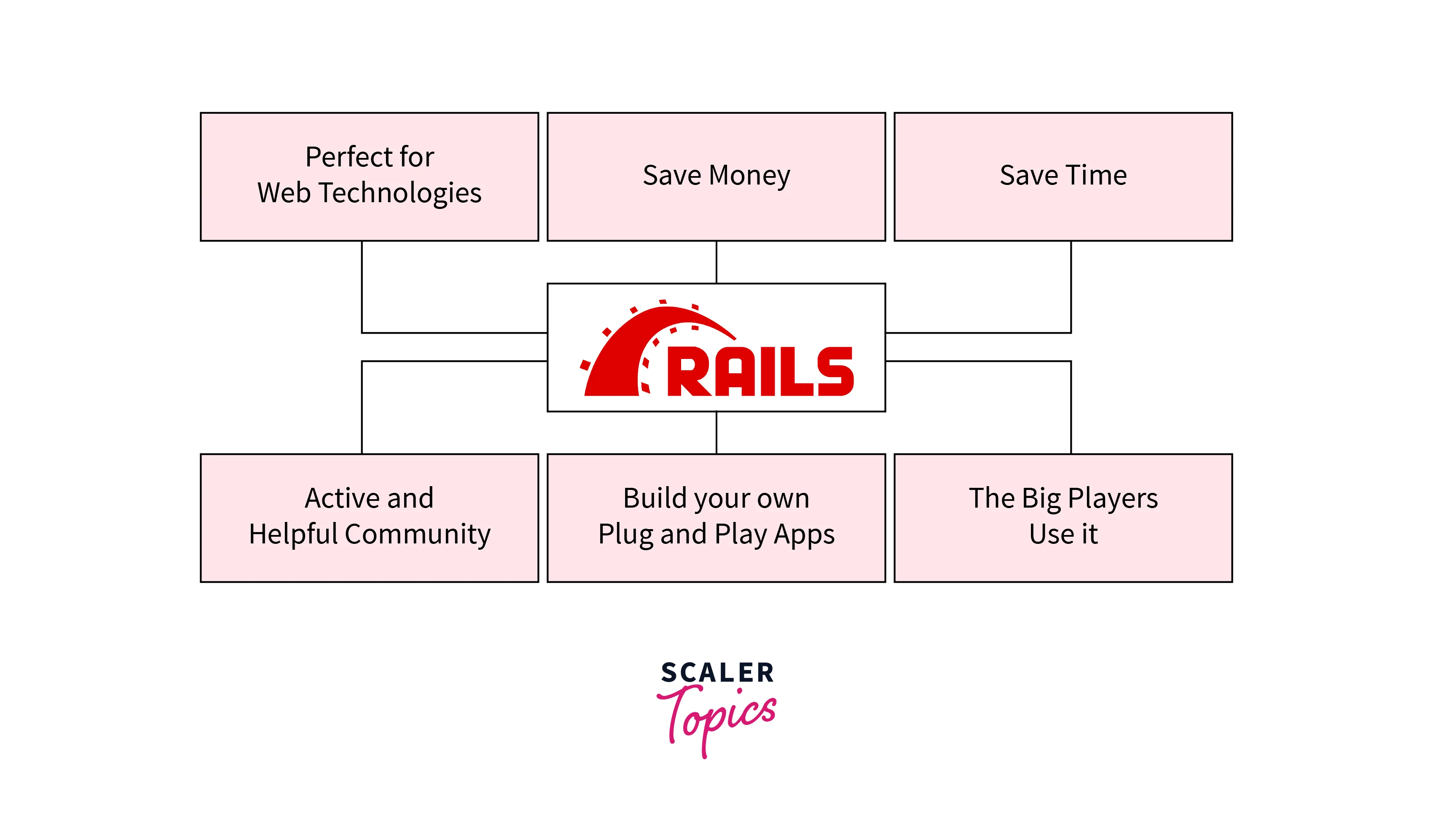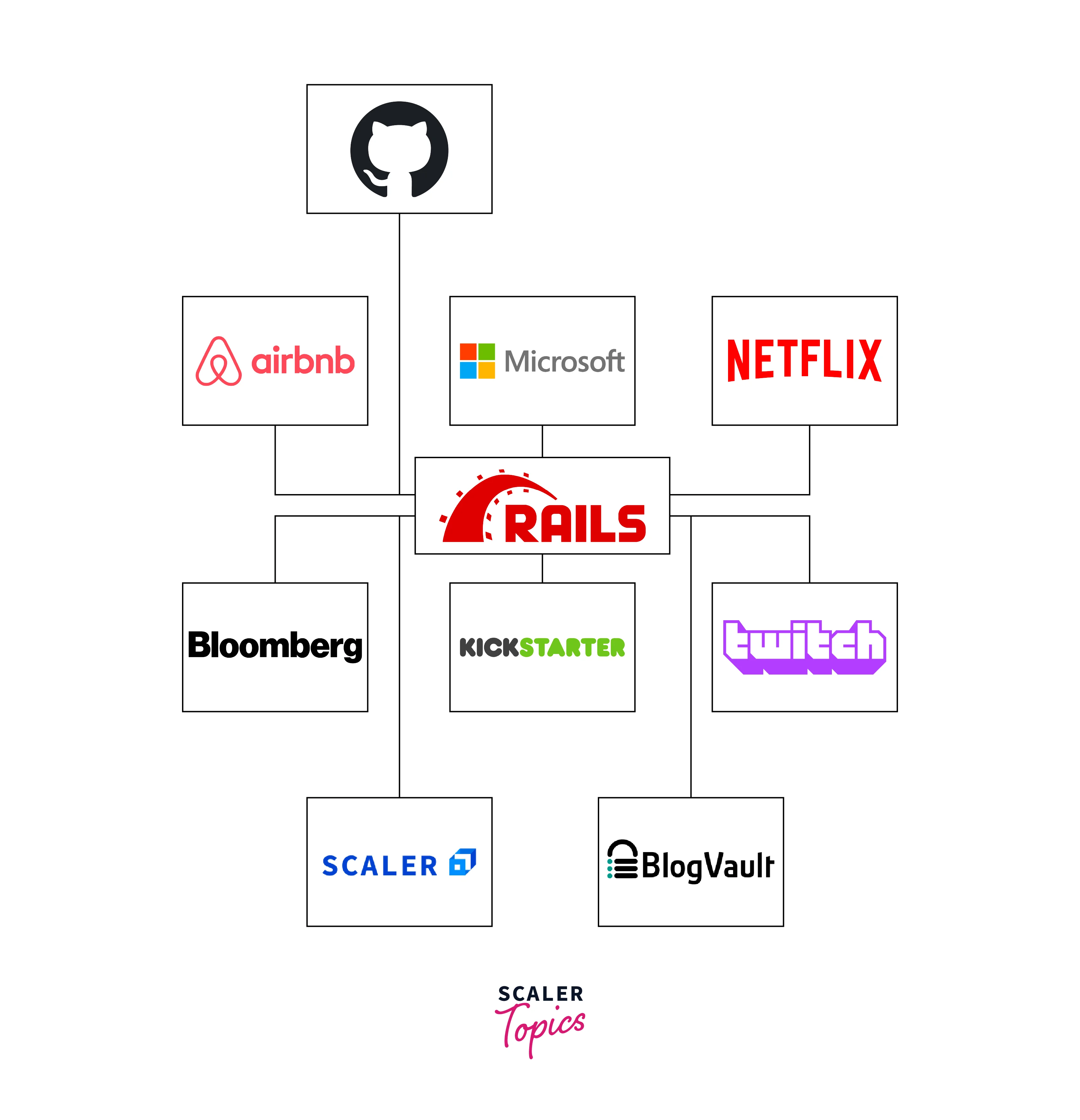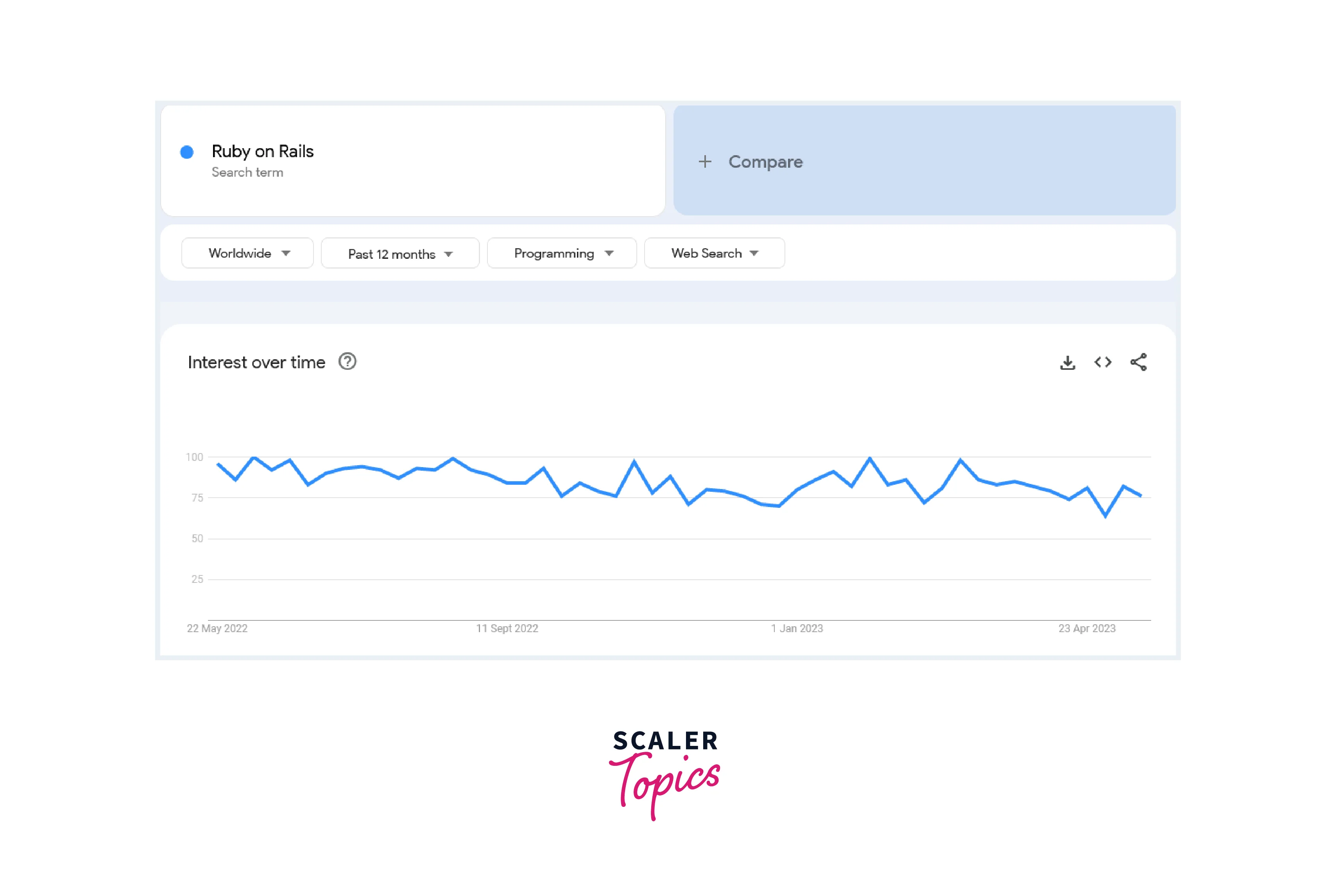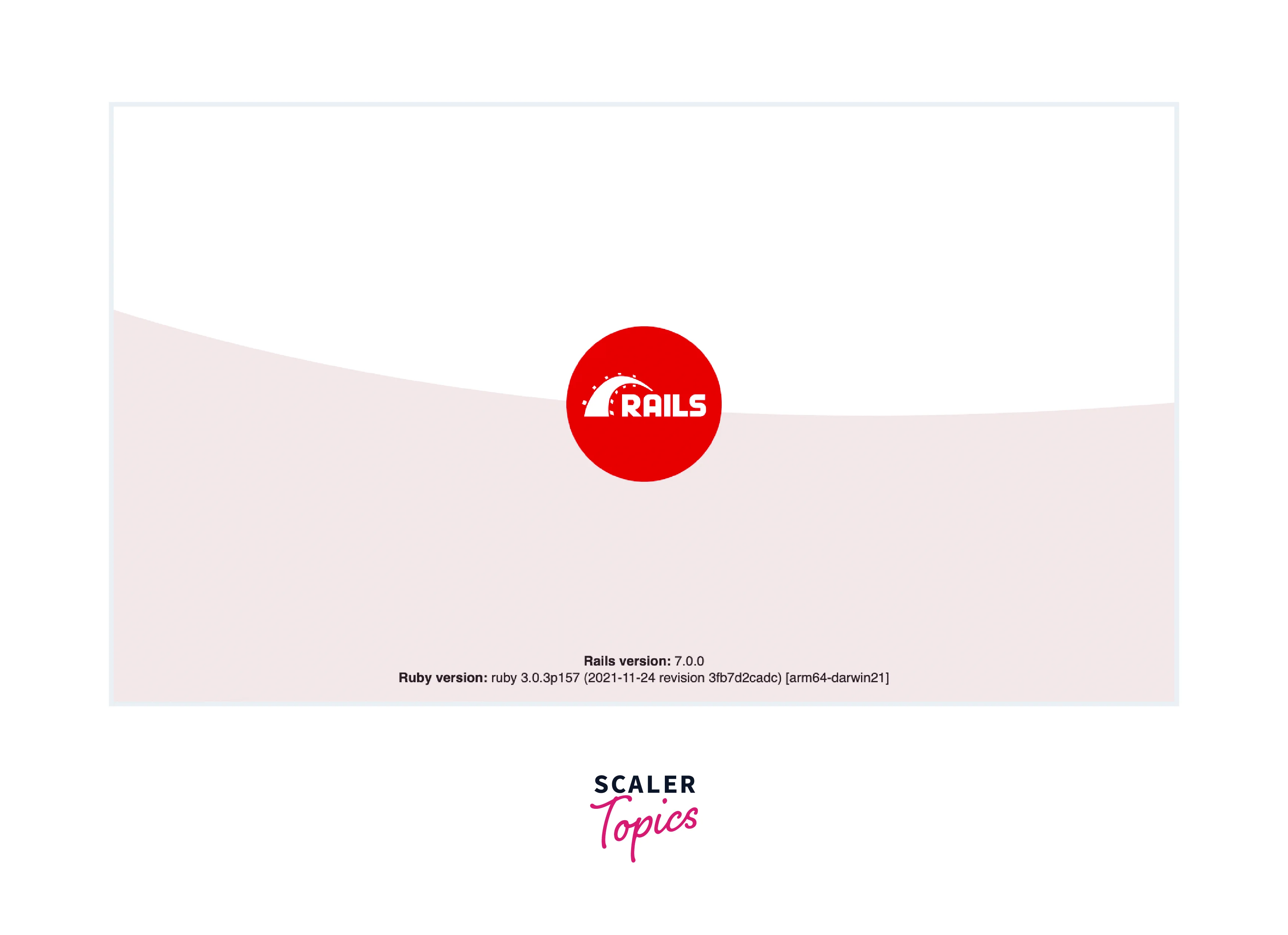Introduction to Ruby on Rails
Overview
Ruby on Rails is a favored framework for web development, offering programmers a powerful toolset to create robust and scalable applications. In this article, we will explore the foundational principles, advantages, limitations, and future prospects of Ruby on Rails.
What is Ruby on Rails?
Ruby on Rails is an open-source framework written in the Ruby programming language. It provides developers with a structured and organized way to develop web applications with its Model-View-Controller (MVC) pattern modularizing the code for maintainbility. One of the key philosophies behind Rails is Convention over Configuration (CoC). It suggests that the framework should make decisions for developers based on conventions, reducing the need for explicit configuration. By adhering to established conventions, Rails simplifies development by eliminating the need for repetitive decisions and setups.

Basic Concepts of Ruby on Rails
Let's explore some of its basic concepts:
Model-View-Controller (MVC) Architecture
Ruby on Rails follows the Model-View-Controller(MVC) architecture, where:
- Model: The model represents the application's data and its business logic. It handles the data storage and retrieval and provides an interface for working with the database without SQL queries.
- View: The view is responsible for presenting the data to the user in a human-readable format. It receives data from the controller and generates the HTML that is sent to the browser.
- Controller: The controller is responsible for handling user input and updating the model. It receives requests from the browser, performs any necessary processing or validation on the input, and updates the model accordingly.
Gems and Packages
Ruby on Rails leverages the power of gems, which are pre-built packages of code, to enhance functionality and streamline development. Gems provide ready-to-use features, such as authentication, data manipulation, and integrations with external services.
Routing
Rails has a powerful routing system that maps incoming requests to specific controller actions. The routing mechanism determines how URLs are structured and directs requests to the appropriate controllers and actions.
Active Record:
Rails incorporates the ActiveRecord ORM, which simplifies database interactions. With Active Record, developers can work with database records as objects, avoiding complex SQL queries.

Why Should We Use Ruby on Rails?
- Rails is built on Ruby, a highly expressive and elegant programming language that promotes clean, readable code and encourages developer happiness.
- Ruby on Rails emphasizes convention over configuration, allowing developers to build applications quickly with less code and fewer configurations, resulting in increased productivity.
- Rails provides a rich set of built-in tools, libraries, and frameworks that expedite development, enabling developers to focus on application logic rather than reinventing the wheel.
- Rails follows sensible conventions, reducing the need for explicit configuration and making it easier for developers to understand and navigate codebases.
- Rails has a mature and thriving ecosystem with a vast collection of gems (libraries) available for various functionalities, enabling developers to leverage existing solutions and accelerate development.
Market Trends
- In the Stack Overflow Developer Survey 2022, Ruby on Rails was ranked 18th, highlighting its presence among developers.
- Google Trends: According to Google Trends data, the search interest for Ruby on Rails has remained steady over the past few years.
- Prominent Users: Several well established and startup companies and organizations, including GitHub, Shopify, Scaler Academy, BlogVault and many more, utilize Ruby on Rails in their technology stacks. These examples demonstrate the continued relevance and adoption of Ruby on Rails in real-world applications, further solidifying its position as a trusted framework in the market.
- Popular companies that are using ruby on rails as their tech stack include:
- Airbnb: Airbnb, the global marketplace for accommodations and experiences, initially started using Ruby on Rails as its primary development framework. Although they have gradually expanded their tech stack, Ruby on Rails played a significant role in their early growth and development.
- Bloomberg: Bloomberg, a renowned financial software, data, and media company, has utilized Ruby on Rails for some of its web applications. Rails has proven valuable in facilitating the development of internal tools and streamlining their workflows.
- GitHub: GitHub, the widely popular web-based platform for version control and collaboration, is built on Ruby on Rails. It utilizes Rails to power various features and functionalities, including repository management, issue tracking, and pull requests.
- Shopify: Shopify, a leading e-commerce platform, relies on Ruby on Rails for its backend infrastructure. Rails helps power the platform's extensive capabilities, such as managing product catalogs, handling payments, and facilitating order processing.

Where Should We Use Ruby on Rails?
Ruby on Rails is a versatile framework that can be employed in various web application development scenarios.
- Rapid Application Development: Ruby on Rails is well-suited for projects that require fast-paced development and frequent iterations. Its conventions and code generation capabilities enable developers to quickly build functional prototypes. Hence, due to fast-paced development, it helps in beating the competitors in the market and the overall TAT(Turn-Around-Time) for feature updates is also significantly reduced.
- E-commerce Platforms: Ruby on Rails provides a solid framework for developing e-commerce applications. Its built-in features, such as Active Record associations and validations, makes it convenient to handle complex data models and relationships. Gems like Spree Commerce and Solidus offer comprehensive e-commerce solutions.
- Social Networking Sites: Ruby on Rails can be a great choice for developing social networking platforms. Its ability to handle user authentication, user-generated content, and complex data relationships simplifies the process of creating social networking features.
- Collaborative Tools and Project Management Systems: Ruby on Rails is well-suited for building collaborative tools and project management systems. Its real-time communication capabilities, combined with gems like Action Cable and WebSockets, enable developers to create interactive and collaborative features. Github is major example of a collaborative application built over Ruby on Rails.
- Future Prospects of Ruby on Rails: To suit the needs of modern web development, Ruby on Rails is constantly changing and adapting. Its vibrant community continuously offers updates and enhancements, ensuring its presence in the ever evolving tech industry. Due to its adaptability and scope for integration, Rails remains an appropriate choice with the growth of emerging technologies like machine learning, AI, and blockchain.
Ruby on Rails Features
- Scaffolding and Code Generation: Rails includes a powerful scaffolding feature that generates boilerplate code, including models, views, and controllers, based on predefined templates.
- Convention over Configuration: By reducing the time spent on repetitive tasks, the need for explicit configuration is minimized, resulting in a faster development process.
- Active Record ORM: Ruby on Rails incorporates the Active Record Object-Relational Mapping (ORM) framework, which simplifies database interactions. It provides an intuitive interface for working with databases, allowing developers to define models, and associations, and perform database operations using familiar Ruby syntax.
- Integrated Testing Framework: Ruby on rails combined with Test-Driven Development (TDD), forms a powerful framework for building robust and maintainable web applications in Ruby on Rails. RSpec, an integrated testing framework included with Ruby on Rails, makes it easier to automate testing and encourages the practice of creating tests alongside code.
Advantages of Ruby on Rails
- Fast application Development: Developers may create apps quickly and effectively thanks to Rails' conventions and built-in functionality. In particular, projects with short deadlines and startups benefit from this development speed.
- Scalability: As applications expand, Rails is ideally suited to handle the scalability. It can handle growing traffic and data volume more easily because to its modular structure and integrated database management tools.
- Productivity: Ruby on Rails places a high priority on the satisfaction and productivity of its developers. The framework's clean syntax and wide-ranging modules exempt developers from writing boilerplate code so they can concentrate on finding solutions and core business logic.
- Support from the community: The Rails community is renowned for its zeal and eagerness to lend a hand. Developers are guaranteed to be able to get assistance and answers to their problems thanks to access to a large selection of gems, documentation, and online resources.
Limitations of Ruby on Rails
- Performance: Ruby is a interpreted language, and hence it is converted to machine code at runtime. Being an interpreted language, Ruby on Rails might not be as efficient as some other frameworks. Alternative frameworks might be more appropriate for applications with high performance demands.
- Learning Curve: Even though Rails is renowned for being developer-friendly, mastering the framework takes time and effort. The norms and notions may first be too much for beginners to handle.
- Flexibility versus Convention: Convention-based development, which is used in Rails, speeds up development but may have certain limitations on flexibility. Additional setting and modification may be needed for projects with special requirements or complex structures.
Example: Creating a Simple Rails Application
Let's walk through the process of creating a simple Rails application. Follow these steps:
-
Install Ruby: Open linux terminal and run the following command to install ruby:
-
Install Rails: Once Ruby is installed, then run the following command to install Rails:
-
Create a New Rails Application: Navigate to the directory where you want to create your Rails application. Then run the following command:
Replace myapp with the desired name of your application. This command creates a new Rails application with the necessary directory structure and initial files.
-
Application Directory: Navigate to the application directory using the following command:
-
Start the Rails Server: To launch the Rails server and view your application in a web browser, run the following command:
This command starts the server on the default port 3000.
-
Access the Application: Open your web browser and go to http://localhost:3000. You should see the default Rails welcome page, which means that your application is up and running.

FAQs
Q: Is Ruby on Rails suitable for small projects?
A: Yes, Ruby on Rails is well-suited for small projects as it emphasizes rapid development and provides a rich set of tools and conventions to streamline the process.
Q: Can I use Ruby on Rails for building APIs?
A: Yes, Ruby on Rails can be used to build robust APIs. Rails provides features such as routing, serialization, and authentication mechanisms that make API development efficient and straightforward.
Q: Is it possible to integrate existing databases with Ruby on Rails?
A: Yes, Ruby on Rails supports connecting to existing databases. You can configure the database settings in the application's configuration files to establish a connection with your desired database.
Conclusion
- Ruby on Rails offers a clean syntax, a convention-over-configuration approach, and a robust web framework, making it ideal for rapid web development and prototyping.
- The framework leverages gems, pre-built packages of code, to enhance functionality and accelerate development.
- Ruby on Rails provides a powerful routing system for mapping URLs to controller actions, creating clean and organized URL structures.
- Popular companies that are using ruby on rails as a part of their tech stack include Github, shopify, Bloomberg, Scaler Academy, and many more.
- Ruby on Rails is a versatile framework that can be employed in various web application development scenarios like e-commerce website, rapid application development, social networking sites, collaborative tools.
- Advantages of Ruby on Rails include developer-friendly syntax, a vibrant community, and streamlined development processes.
- Limitations of Ruby on Rails involve scalability challenges under extreme traffic loads and a learning curve for newcomers.
